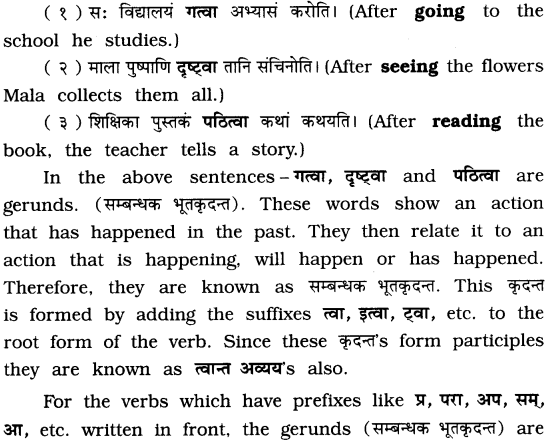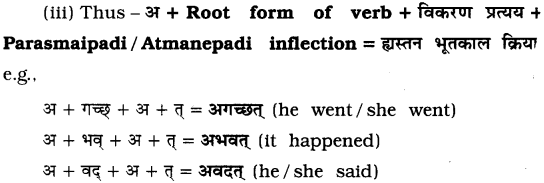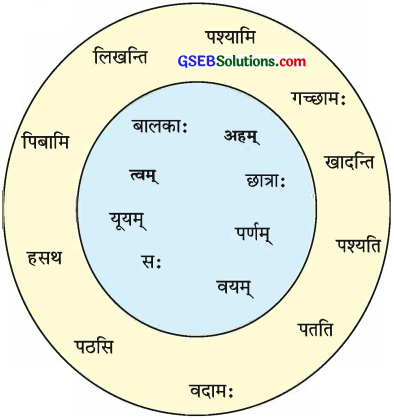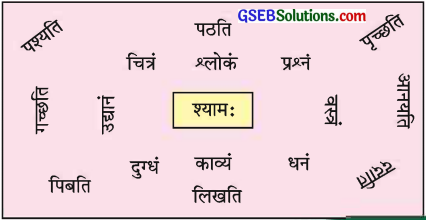Gujarat Board GSEB Solutions Class 8 Sanskrit भाषासज्जता Textbook Exercise Questions and Answers, Notes Pdf.
Gujarat Board Class 8 Sanskrit भाषासज्जता
GSEB Class 8 Sanskrit भाषासज्जता Questions and Answers
It is necessary that students gain knowledge and ability about the practical use of language. For this it is necessary to understand a few special features of Sanskrit. Here, we will try to expand our abilities by studying just such aspects.
![]()
कृदन्तानि (Participles)
When the suffix za is added to root forms (of verbs) कृदन्त’s are formed – (कृत् + अन्त). To understand the use of these words let us first understand the useful Gir’s (gerunds or participles).
सम्बन्धक भूतकृदन्तम् (Gerund)
Read the following sentences :


![]()
Translate the following sentences into Sanskrit :
- After going to the office Krishna Prasad converses.
अनुवादः कृष्णप्रसादः कार्यालयं गत्वा वार्तालापं करोति। - After listening to the song Radhikā experiences happiness.
अनुवादः राधिका गीतं श्रुत्वा (आकर्ण्य) आनन्दम् अनुभवति। - After taking a bath I drink milk.
अनुवादः अहं स्नानं कृत्वा दुग्धं पिबामि।
हेत्वर्थ कदन्तम् (Infinitive of Purpose)
In every day life sentences like – “I want to do…” are used more frequently; e.g.,
- I want to go. (Wish to go.) – अहं गन्तुम् इच्छामि।
- She wants to play. – सा रन्तुम् (खेलितुम्) इच्छति।
- He is not able to see. (He cannot see.)- सः द्रष्टुम् न शक्नोति।
In the above sentences the words गन्तुम्, रन्तुम्, खेलितुम् and द्रष्टुम् are known as हेत्वर्थ कृदन्त. When the suffixes तुम्, इतुम्, टुम्, धुम्, etc. are added to the root forms of verbs this type of Grey is formed. Therefore, this chG7 is known as तुमन्त अव्यय. This कृदन्त is also an अव्यय type of कृदन्त just like the सम्बन्धक भूतकृदन्त.
Some हेत्वर्थ कृदन्त’s (Infinitives of Purpose) :
पा – पातुम् (to drink), दा – दातुम् (to give), गै- गातुम् (to sing), नी – नेतुम् (to take along), पठ् – पठितुम् (to read), क्रीड्- क्रीडितुम् (to play), चल् – चलितुम् (to walk), खाद् – खादितुम् (to eat), कथ् – कथयितुम् (to say), रच् – रचयितुम् (to create), etc.
Translate the following sentences into Sanskrit :
- He wants to take the examination.
अनुवाद : सः (सा) परीक्षां दातुम् इच्छति। - He wants to drink water.
अनुवाद : सः (सा) पानीयं पातुम् इच्छति। - I want to read a book.
अनुवाद : अहं पुस्तकं पठितुम् इच्छामि।
![]()
Activity
- Find and discuss the forms of infinitives (हेत्वर्थ कृदन्त) which are there in the textbook of Semester II in the class.
विध्यर्थ कृदन्तम् or विध्यर्थ कर्मणि कृदन्तम् (Potential Participle)
Read and understand the following sentences :
(1) Mother should always be respected. – माता सदा वन्दनीया।
(2) Truth should always be practised. – सत्यं सदा नाचरणीयम्।
(3) We should remember by heart. – मनसा सततं स्मरणीयम्। In the above sentences the words वन्दनीया, आचरणीयम् and स्मरणीयम् are Potential passive participles. They are called विध्यर्थ कृदन्त’s or विध्यर्थ कर्मणि कृदन्त’s. This form changes its gender according to the noun it qualifies. i.e., according to the noun it is used for; e.g., वन्दनीयः worth-respecting पिता, वन्दनीया worth-respecting जननी, वन्दनीयम् worth-respecting तीर्थम्।
ह्यस्तन भूतकालः (प्रथम भूतकालः – The Simple Past Tense)
In Sanskrit there are three types of Past Tenses : ह्यस्तन भूतकाल, परोक्ष भूतकाल and अद्यतन भूतकाल. Here we have introduced only the front since it is more used in every day conversations.
Read the following sentences and understand the underlined forms of verbs :
- एकदा सः द्रोणाचार्यस्य समीपम् अगच्छत् अवदत् च।
- शनैः शनैः सः कुशलः धनुर्धरः अभवत्।
The above sentences are taken from the lesson आत्म: श्रद्धायाः बलम्। The words अगच्छत्, अवदत् and अभवत् which have been used in the above sentences are forms of simple (or imperfect) past tense. Remember the following facts about these forms:
(i) The simple (or imperfect) past tense is used to talk about an action which has finished in the recent past.
(ii) The sign of हास्तन भूतकाल is the prefix ‘अ’. It is always written before the root of the verb.
![]()

अव्ययम् (Indeclinable)
The words which do not change (व्यय) according to the gender of the noun or pronoun, the number of the noun / pronoun, tense of the verb or form of the adjective are called अव्यय (indeclinables). Generally, an अव्यय is used to present a point emphatically, ask a question or describe something vividly (in detail).
Given below are some indeclinables (अव्ययs) and their uses. Study them :
- यदा … तदा (when … then …)
यदा काकः आहारार्थं गच्छति तदा सर्पः एकं शावकं खादति। - यदि … तर्हि (if … then …)
यदि धनम् इच्छसि तर्हि परिश्रमं कुरु। - (३) यथा … तथा (as … so …)
यथा राजा तथा प्रजा। यथा करिष्यसि तथा प्राप्स्यसि। (करिष्यसि – you will do, प्राप्स्यसि – you will get) - अत्र … तत्र (here … there …)
अत्र पुण्यं कुरु तत्र लभस्व। - अपि (but, at the beginning of a sentence ‘What ?’)
- गुरुदेव, अहम् अपि (also) तव शिष्यः भवितुम् इच्छामि।
- अपि भवान् सुखम् इच्छति?
- अन्यथा (otherwise, if not)
नय माम्, अन्यथा अहं त्वां खादिष्यामि। - अधुना (now)
अधुना वयं सुखेन वसामः। - अद्य (today)
अद्य सोमवासरः अस्ति। - वा (or)
नदीजलेन कूपजलेन वा वृक्षस्य सेचनं भवति। - सर्वदा (always)
अहं सर्वदा सत्यं वदामि। - अन्यत्र (elsewhere)
जलस्य अभावे जनाः अन्यत्र गच्छन्ति। - एव (the same, itself)
सन्तोषः एव पुरुषस्य परं निधानम्। - उच्चैः (loudly)
विप्राः उच्चैः वेदपाठं कुर्वन्ति। - नीचैः (softly, slowly)
मम भगिनी नीचैः भाषते। - प्रति (towards; the noun towards which motion happens is written in accusative form.)
बालकाः विद्यालयं प्रति गच्छन्ति।
![]()
Sanskrit Digest Std 8 GSEB भाषासज्जता Additional Questions and Answers
1. Choose the correct option for the answer of the questions given below :
પ્રશ્ન 1.
Which is the suffix of relative past participle ?
A. तुम्
B. त्वा
C. तम्
D. अनीय
उत्तर:
B. त्वा
પ્રશ્ન 2.
Which is the suffix of infinitives of purpose ?
A. त्वा
B. तुम्
C. त
D. अनीयम्
उत्तर:
B. तुम्
પ્રશ્ન 3.
सा पुस्तकालयं गत्वा पुस्तकम् आनयति।- रेखाङ्कितः कृदन्तस्य प्रकार कः अस्ति?
A. Relative past participle
B. Potential participle
C. Infinitive of purpose
D. Passive past participle
उत्तर:
A. Relative past participle
![]()
પ્રશ્ન 4.
‘आगम्य’ शब्दस्य कृदन्तप्रकारः कः अस्ति?
A. Passive past participle
B. Infinitive of purpose
C. Relative past participle
D. Potential participle
उत्तर:
C. Relative past participle
પ્રશ્ન 5.
‘अहं गन्तुम् इच्छामि।’ – रेखाङ्कितस्य कृदन्तस्य प्रकारः कः अस्ति?
A. Relative past participle
B. Infinitive of purpose
C. Potential participle
D. Passive past participle
उत्तर:
B. Infinitive of purpose
પ્રશ્ન 6.
‘सत्यं सदा आचरणीयम्।’ – रेखाङ्कितस्य कृदन्तस्य प्रकारः कः अस्ति?
A. Relative past participle
B. Infinitive of purpose
C. Potential participle
D. Passive past participle
उत्तर:
C. Potential participle
![]()
પ્રશ્ન 7.
______________________ राजा तथा प्रजा। – रिक्तस्थाने उचितम् अव्ययपदं किम्?
A. यदि
B. अपि
C. अत्र
D. यथा
उत्तर:
D. यथा
પ્રશ્ન 8.
______________________ वयं सुखेन वसामः। – रिक्तस्थाने उचितम् अव्ययपदं किम्?
A. अद्य
B. अन्यथा
C. सर्वदा
D. अधुना
उत्तर:
D. अधुना
પ્રશ્ન 9.
अधोदत्तेभ्यः धातुरूपेभ्यः ह्यस्तनभूतकाल अन्यपुरुष एकवचनस्य रूपं किम् अस्ति ?
A. अवदत्
B. अवदः
C. अवदतम्
D. अवदन्
उत्तर:
A. अवदत्
![]()
પ્રશ્ન 10.
अधोदत्तेभ्यः धातुरूपेभ्यः ह्यस्तनभूतकाल अन्यपुरुष बहुवचनस्य रूपं किम् अस्ति ?
A. अभवत्
B. अभवाम
C. अभवन्
D. अभवत
उत्तर:
C. अभवन्
2. Write relative past participle of following roots :
- नम् – नत्वा
- मन् – मत्वा
- जि -जित्वा
- नी. – नीत्वा
- रच् – रचायत्वा
- आ + गम् – आगम्य
- आ + नय् – आनीय
- प्र + नम् – प्रणम्य
3. Write potential participle of following roots :
- वन्द् – वन्दनीयः, वन्दनीयम्, वन्दनीया
- आ + चर् – आचरणीयम्, आचरणीयः, आचरणीया
- पठ् – पठनीयः, पठनीयम्, पठनीया
- गम् (गच्छ) – गमनीयः, गमनीयम्, गमनीया
- कथ् -कथनीयः, कथनीयम्, कथनीया
- कृ – करणीयम्, करणीयः, करणीया
![]()
4. Translate the following sentences in English :
પ્રશ્ન 1.
सः पत्रं लिखित्वा बहिः अगच्छत्।
Answer:
After writing letter he went out.
પ્રશ્ન 2.
अहं गन्तुम् इच्छामि।
Answer:
I want to go.
પ્રશ્ન 3.
माता सदा वन्दनीया।
Answer:
Mother is always admirable.
પ્રશ્ન 4.
अत्र अनेकानि चित्राणि सन्ति।
Answer:
There are many pictures here.
પ્રશ્ન 5.
सन्तोषः एव पुरुषस्य परं निधानम्।
Answer:
Satisfaction is the best treasure of a man.
5. Translate the following sentences in Sanskrit :
પ્રશ્ન 1.
He wants to give the examination.
उत्तर:
सः (सा) परीक्षां दातुम् इच्छति।
પ્રશ્ન 2.
Today is Monday.
उत्तर:
अद्य सोमवासरः (अस्ति)।
![]()
પ્રશ્ન 3.
My sister speaks slowly.
उत्तर:
मम भगिनी नीचैः भाषते (वदति)।
પ્રશ્ન 4.
I want to read the book.
उत्तर:
अहं पुस्तकं पठितुम् इच्छामि।
પ્રશ્ન 5.
After listening to the song, Radhika feels happiness.
उत्तर:
राधिका गीतं श्रुत्वा (आकर्ण्य) आनन्दम् अनुभवति।
भाषाक्रीडा (The Game of Language 1)
Note : Choosing a noun from the inner small the outer bigger circle match it with a verb from circle and frame sentences.
Example : त्वं पठसि।

Sentences :
- बालकाः लिखन्ति।
- त्वं हससि।
- यूयम् हसथ।
- सः लिखति।
- अहं पश्यामि।
- छात्राः खादन्ति।
- सः पश्यति।
- पर्णम् पतति।
- वयं वदामः।
- वयम् गच्छामः।
- छात्राः लिखन्ति।
- बालकाः पश्यन्ति।
![]()
भाषाक्रीडा (The Game of Language 2)
Note: In the small square in the centre : श्यामः is given as the subject (doer). Join it with verbs and objects appropriately to frame new sentences.
Example : श्यामः धनं ददाति।

Sentences :
- श्यामः चित्रं पश्यति।
- श्यामः श्लोकं पठति।
- श्यामः प्रश्नं पृच्छति।
- श्यामः उद्यानं गच्छति।
- श्यामः वस्त्रम् आनयति।
- श्यामः दुग्धं पिबति।
- श्यामः काव्यं पठति।
- श्यामः धनं पश्यति।
- श्यामः वस्त्रं पश्यति।
- श्यामः श्लोकं ददाति।
- श्यामः धनम् आनयति।
![]()
Note: Other sentences of this type can be framed in Language Game 1 and 2.